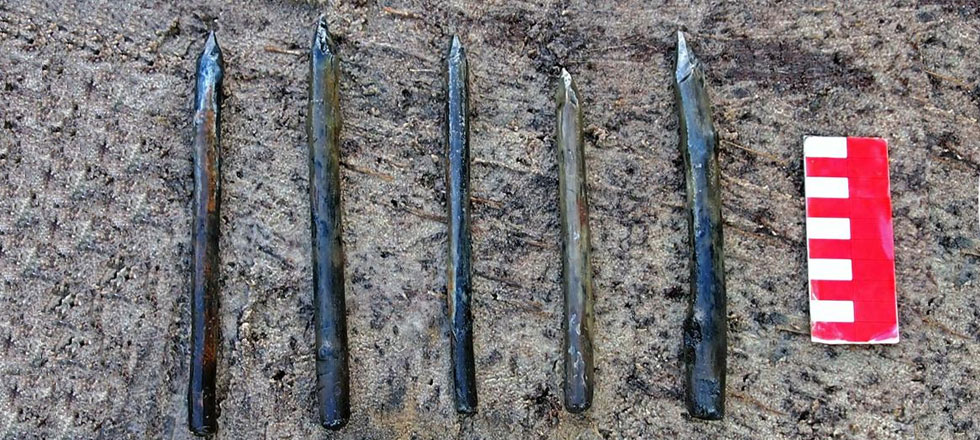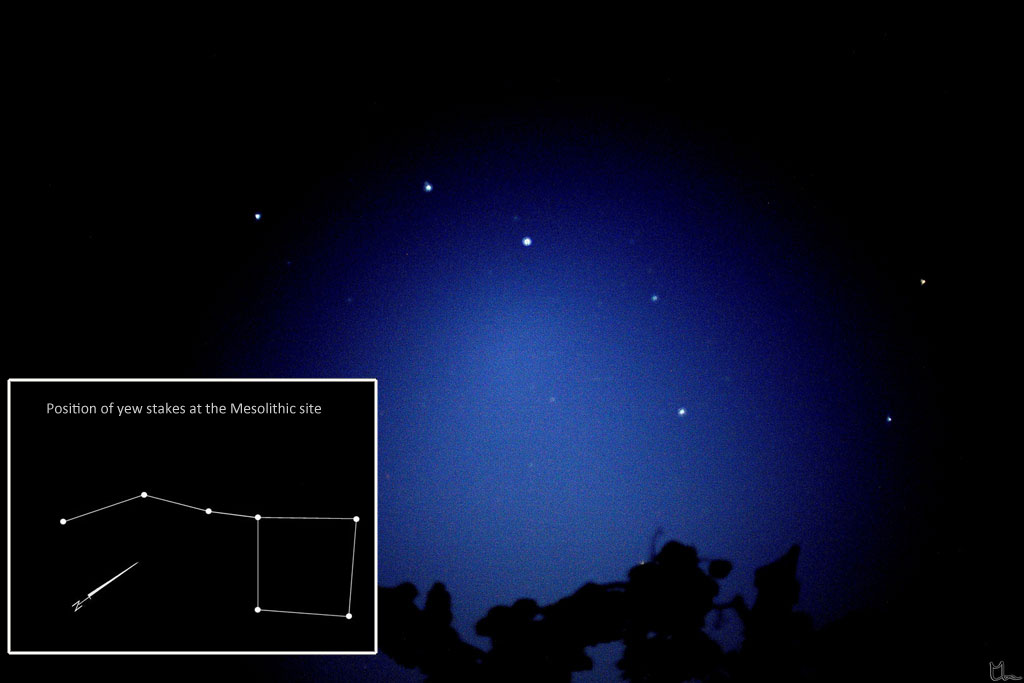It looks like you're using an Ad Blocker.
Please white-list or disable AboveTopSecret.com in your ad-blocking tool.
Thank you.
Some features of ATS will be disabled while you continue to use an ad-blocker.
11
share:

MESOLITHIC SANCTUARY REVEALS CONSTELLATION RIDDLE
Evidence for ritual and possible astronomical practices during the Mesolithic period, 9000 years ago, has been uncovered in Bolków by lake Świdwie, Western Pomerania, by archaeologists from the Institute of Archaeology and Ethnology in Szczecin, Poland.
This Mesolithic-era site recently became famous for the artefacts found at one particular hut. A number of possible shamanistic ritual objects along with a fragment of meteorite were discovered last year.
Article about meteorite find in June here. As if the find of meteorite fragments within a Mesolithic site wasn't intriguing enough, the yew stakes pictured at top were arranged in a very familiar pattern:
In addition to the structures made of pine and aspen poles the archaeologists also found seven perfectly preserved yew stakes stuck into the ground on what can only be described as a very recognisable pattern. According to Prof. Galiński it seems plausible they reflect a part of what we now call the constellation of Ursa Major (the Great Bear) – the brightest of the stars that make up Ursa Major are known as the Big Dipper or Plough.

How cool is that?
edit on 2014-9-25 by theantediluvian because: shortened title
a reply to: theantediluvian
That is certainly interesting but I would still want to see the entire excavation diagram; I'm wondering if these are the only stakes noted or the other stakes.
I could see where a shaman type would have gotten quite excited to see a light in the sky and recover a rock. It might also have been a relic handed down from an earlier find..
Good stuff and thanks for posting this.
That is certainly interesting but I would still want to see the entire excavation diagram; I'm wondering if these are the only stakes noted or the other stakes.
I could see where a shaman type would have gotten quite excited to see a light in the sky and recover a rock. It might also have been a relic handed down from an earlier find..
Good stuff and thanks for posting this.
originally posted by: Hanslune
a reply to: theantediluvian
That is certainly interesting but I would still want to see the entire excavation diagram; I'm wondering if these are the only stakes noted or the other stakes.
I could see where a shaman type would have gotten quite excited to see a light in the sky and recover a rock. It might also have been a relic handed down from an earlier find..
Good stuff and thanks for posting this.
I'd like to see it as well but I haven't been able to track down a paper containing the excavation diagram. I've been wondering to myself how a shaman living in 7,000 BC would come to possess fragments of a meteorite — that is, how would he have determined it was a fragment of a meteorite unless it was witnessed falling during a meteor shower?
I've seen world population estimates of approximately 5 million in 7,000 BC. That's a whole lot less people to encounter meteorites as they're falling. Though given enough time, the opportunities greatly increase so I imagine it's plausible that the fragments could have even been handed down through the generations, from shaman to shaman.
The other thing that occurs to me is the that there could be a possible link between the meteorite fragments and Ursa Major / the Big Dipper as there is a smaller meteor shower, the Alpha Ursa Majorids, that is a very minor stream these days but may have had been considerably denser 9,000 years ago.
Finally, it bears mention (pun intended!) that the stakes were laid out in representation of the Big Dipper only which seems to preclude an interpretation that these people had an appreciation of Ursa Major as a constellation representing a bear (a prehistoric meme in many regions).
edit on 2014-9-25 by theantediluvian because: (no reason given)
a reply to: theantediluvian
That is very possible I had not considered it. I know that much much later swords were cold/warm hammered out of meteorite iron and gave rise to the some of the legends of 'magic' swords, as such weapons would have been superior to the bronze and early iron ones. Just a story however.
The other thing that occurs to me is the that there could be a possible link between the meteorite fragments and Ursa Major / the Big Dipper as there is a smaller meteor shower, the Alpha Ursa Majorids, that is a very minor stream these days but may have had been considerably denser 9,000 years ago.
That is very possible I had not considered it. I know that much much later swords were cold/warm hammered out of meteorite iron and gave rise to the some of the legends of 'magic' swords, as such weapons would have been superior to the bronze and early iron ones. Just a story however.
It's hard for anyone who had never been out to sea especially under the skies of the southern cross to view the stars as I have away from the glare
of the cities ,the stars went from horizon to horizon 360% our ancestors would be treated to such views they could not help them selves from taking
note and tracking those bodies.
Btw the Ishango bones of the Congo was used as a lunar calendar as well as a Mathematical devise was at 25kyrs old and the Lebombo bone 37kyrs or 35kyrs was even earlier that this link said is still used by the Khoisan people today .
www.math.buffalo.edu...
Btw the Ishango bones of the Congo was used as a lunar calendar as well as a Mathematical devise was at 25kyrs old and the Lebombo bone 37kyrs or 35kyrs was even earlier that this link said is still used by the Khoisan people today .
www.math.buffalo.edu...
originally posted by: Spider879
It's hard for anyone who had never been out to sea especially under the skies of the southern cross to view the stars as I have away from the glare of the cities ,the stars went from horizon to horizon 360% our ancestors would be treated to such views they could not help them selves from taking note and tracking those bodies.
I've been in utter darkness in the hills of North Carolina. It's amazing.
But "360 degrees"? Must have been one tall ship!
Harte
originally posted by: Harte
originally posted by: Spider879
It's hard for anyone who had never been out to sea especially under the skies of the southern cross to view the stars as I have away from the glare of the cities ,the stars went from horizon to horizon 360% our ancestors would be treated to such views they could not help them selves from taking note and tracking those bodies.
I've been in utter darkness in the hills of North Carolina. It's amazing.
Harte
The lights in China, India, Japan etc effect how you see the night sky. Global air pollution affects how you see the night sky. In a pre-industrialized world, the heavens were surely a sight to see.
I've been fortunate to seen the fully glory of the pre-industrial sky, in India, on the edge of the empty quarter and several times in the
Himalayas, in a boat in the Gulf of Oman and even in the 'wilds' of Oregon and Kansas. When the moon has not risen it is a glorious sight. It is
easy to see why man was so taken with the sky and it made him wonder why it moved and what it meant.
I slept one night on the side of Raraku Rano and watched the heavens move above me the entire night.
I slept one night on the side of Raraku Rano and watched the heavens move above me the entire night.
new topics
-
WF Killer Patents & Secret Science Vol. 1 | Free Energy & Anti-Gravity Cover-Ups
General Conspiracies: 2 minutes ago -
Hurt my hip; should I go see a Doctor
General Chit Chat: 51 minutes ago -
Israel attacking Iran again.
Middle East Issues: 2 hours ago -
Michigan school district cancels lesson on gender identity and pronouns after backlash
Education and Media: 2 hours ago -
When an Angel gets his or her wings
Religion, Faith, And Theology: 2 hours ago -
Comparing the theology of Paul and Hebrews
Religion, Faith, And Theology: 3 hours ago -
Pentagon acknowledges secret UFO project, the Kona Blue program | Vargas Reports
Aliens and UFOs: 4 hours ago -
Boston Dynamics say Farewell to Atlas
Science & Technology: 4 hours ago -
I hate dreaming
Rant: 5 hours ago -
Man sets himself on fire outside Donald Trump trial
Mainstream News: 7 hours ago
top topics
-
The Democrats Take Control the House - Look what happened while you were sleeping
US Political Madness: 8 hours ago, 18 flags -
In an Historic First, In N Out Burger Permanently Closes a Location
Mainstream News: 10 hours ago, 16 flags -
A man of the people
Medical Issues & Conspiracies: 15 hours ago, 11 flags -
Biden says little kids flip him the bird all the time.
Politicians & People: 7 hours ago, 8 flags -
Man sets himself on fire outside Donald Trump trial
Mainstream News: 7 hours ago, 7 flags -
Pentagon acknowledges secret UFO project, the Kona Blue program | Vargas Reports
Aliens and UFOs: 4 hours ago, 6 flags -
Israel attacking Iran again.
Middle East Issues: 2 hours ago, 5 flags -
Michigan school district cancels lesson on gender identity and pronouns after backlash
Education and Media: 2 hours ago, 4 flags -
4 plans of US elites to defeat Russia
New World Order: 17 hours ago, 4 flags -
Boston Dynamics say Farewell to Atlas
Science & Technology: 4 hours ago, 4 flags
active topics
-
WF Killer Patents & Secret Science Vol. 1 | Free Energy & Anti-Gravity Cover-Ups
General Conspiracies • 0 • : 727Sky -
Boston Dynamics say Farewell to Atlas
Science & Technology • 5 • : Caver78 -
Hurt my hip; should I go see a Doctor
General Chit Chat • 7 • : randomtangentsrme -
Biden says little kids flip him the bird all the time.
Politicians & People • 16 • : stelth2 -
When an Angel gets his or her wings
Religion, Faith, And Theology • 2 • : stelth2 -
MULTIPLE SKYMASTER MESSAGES GOING OUT
World War Three • 51 • : Zaphod58 -
Israel attacking Iran again.
Middle East Issues • 19 • : stelth2 -
Pentagon acknowledges secret UFO project, the Kona Blue program | Vargas Reports
Aliens and UFOs • 7 • : Ophiuchus1 -
-@TH3WH17ERABB17- -Q- ---TIME TO SHOW THE WORLD--- -Part- --44--
Dissecting Disinformation • 549 • : cherokeetroy -
In an Historic First, In N Out Burger Permanently Closes a Location
Mainstream News • 9 • : VariedcodeSole
11
